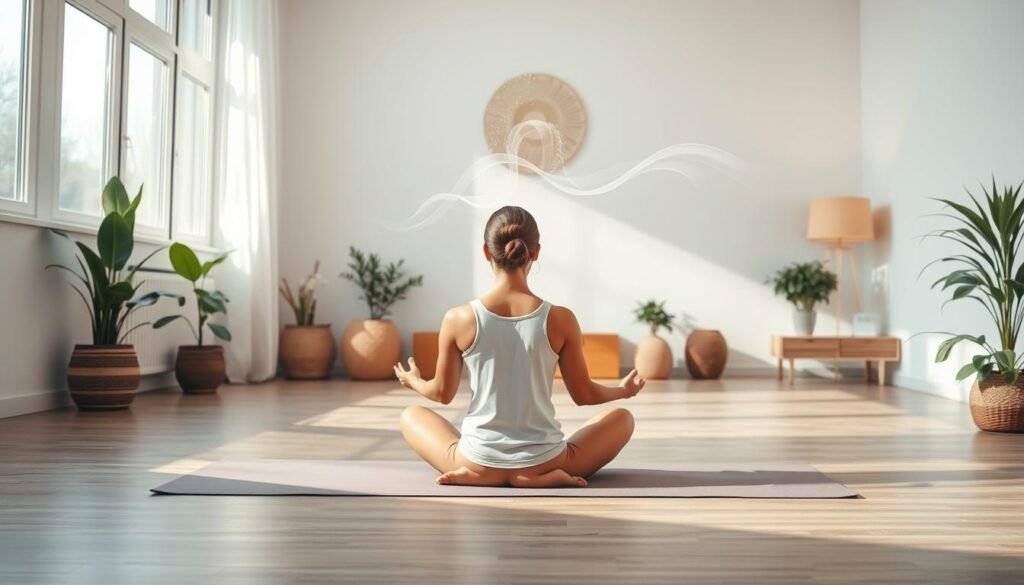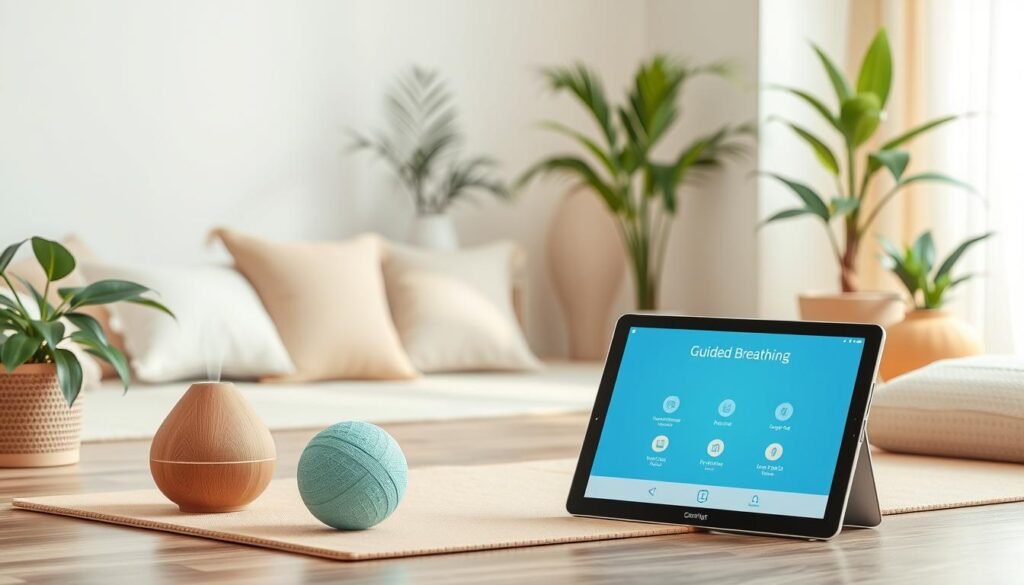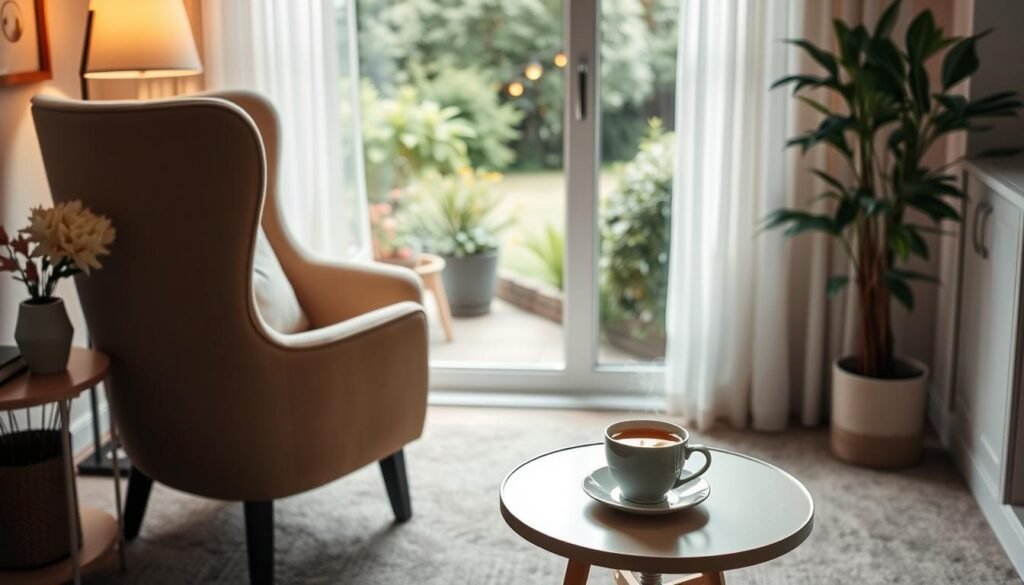Did you know that one in five people live with an anxiety disorder? It’s a condition that can deeply influence their daily life, including their breathing. Anxiety impacts breathing in significant ways, causing symptoms such as shortness of breath, tightness in the chest, and erratic breathing. This happens when stress triggers the body’s fight-or-flight response, creating a challenging cycle of anxiety and breathing issues. This article will help you understand this critical link and offer tips on noticing the signs and managing symptoms.
Key Takeaways
- One in five individuals experiences an anxiety disorder that can affect breathing.
- Shortness of breath is a common symptom associated with anxiety disorders.
- Anxiety can lead to rapid breathing and hyperventilation, intensifying panic.
- Breathing exercises can help regulate breathing patterns during episodes of anxiety.
- Recognizing changes in breathing can aid in managing anxiety symptoms effectively.
Understanding Anxiety and Its Symptoms
Anxiety affects many people differently. It can cause stress that impacts daily life. Knowing the signs of anxiety helps in seeking the right support.
Common Experiences Associated with Anxiety
Many feel anxiety as fear or tiredness. It can make focusing hard. Physical symptoms, like shaking or sweating, are also common. An increased heart rate shows anxiety too. Problems with digestion, constant worries, and being easily upset can happen. These issues come from stress hormones. To learn more, click here.
The Impact of Anxiety Disorders
Anxiety disorders cause too much worry. They can change how you breathe. People may feel they can’t breathe well. This highlights why knowing about anxiety is crucial. Relaxation and light exercise can help manage these feelings. Understanding anxiety disorders improves how we deal with them and get support.
The Role of the Respiratory System in Anxiety
Anxiety doesn’t just affect the mind. It also hits the body, especially the respiratory system. Understanding how we breathe is key to knowing how anxiety shows up physically. This insight is crucial for finding the right treatments.
How the Respiratory System Functions
The respiratory system is vital for keeping the body balanced. It makes sure oxygen and carbon dioxide are swapped out properly. Our bodies need a constant supply of oxygen to work right.
But, anxiety can mess with this system. It can lead to fast or shallow breathing. This makes it tough for enough oxygen to get to important places, like the brain.
The Connection Between Breathing and Emotions
How we breathe is closely tied to how we feel. Anxiety can start a cycle where breathing weirdly makes panic and stress worse. This link between breathing and feelings shows we can use breathing exercises as treatments.
Practices like diaphragmatic breathing can fight the body’s stress reactions. They bring calm and balance.
How Anxiety Affects Breathing Patterns
Anxiety changes how we breathe. It can lead to a feeling called dyspnea, or shortness of breath. When people feel anxious, they might feel like they can’t breathe well. This can cause panic and make the anxiety worse, leading to shallow breaths.
Dyspnea: Shortness of Breath Explained
Dyspnea feels like you are struggling to breathe. It happens when you’re very anxious. The body reacts to fear by taking quick, shallow breaths. This makes the feeling of not getting enough air worse. So, it’s important to know about this cycle between anxiety and breathing.
Effects of Anxiety on Breathing Rate and Depth
Anxiety changes how fast and deep you breathe. Under stress, you breathe faster and not as deep. This can make it hard for your body to get the oxygen it needs. You might feel uncomfortable or uneasy. Doing deep breathing exercises can help. They make you breathe slower and deeper, which can calm you down. These techniques are helpful for people who have anxiety and trouble breathing.
Studies show that paying attention to your breathing can make anxiety better. For more about how breathing techniques can help anxiety, check out this article here.
| Breathing Patterns | Anxiety Level | Impact on Physical Health |
|---|---|---|
| Shallow Breathing | High Anxiety | Increased heart rate and blood pressure |
| Normal Breathing | Low Anxiety | Stabilized heart rate and blood pressure |
| Deep Breathing | Moderate Anxiety | Reduced stress and improved relaxation |
Recognizing Breathing Changes Associated with Anxiety
It’s important to notice breathing changes if you feel anxious. Shallow breaths and feeling tight in the chest are common. They can affect how you live each day. Knowing these signs is the first step to managing your anxiety better.
Shallow Breathing and Its Implications
Shallow breathing is when you breathe quickly and only use the top part of your chest. This can make you get less oxygen, which might make you feel more anxious. Since over 40 million Americans deal with anxiety every year, spotting shallow breathing is crucial. Learning deeper breathing techniques can improve this condition and make you feel better.
Chest Tightness as a Common Symptom
Chest tightness, described as a heavy feeling in the chest, is a common sign of anxiety. This can lead to more panic and worry, which can make your breathing issues worse. Knowing that chest tightness is linked to anxiety can help. This understanding can lead you to find ways to deal with these feelings.
| Symptom | Description | Possible Effects |
|---|---|---|
| Shallow Breathing | Short, quick breaths using the upper chest. | Decreased oxygen intake, increased anxiety. |
| Chest Tightness | Pressing sensation felt in the chest. | Heightened feelings of panic, misinterpretation of sensations. |
Stress-Induced Hyperventilation: What to Know
Hyperventilation is often a sign of anxiety. It makes you breathe rapidly and deeply. This causes a drop in carbon dioxide in your bloodstream. This response can make feelings of anxiety worse, leading to more panic. Half of the people with panic disorder hyperventilate because of stress. Also, 25% of people with hyperventilation syndrome may get panic disorder later.
Understanding Hyperventilation in Anxiety
Hyperventilation can make you feel lightheaded, have chest pain, and muscle spasms. Emotional events like panic attacks can cause it. Lung diseases and heart issues can too. Symptoms of hyperventilation syndrome include:
- Lightheadedness and dizziness
- Shortness of breath
- Numbness or tingling in extremities
- Weakness and confusion
- Anxiety and fear
Knowing these symptoms can help people manage their anxiety better. This can lessen hyperventilation episodes. Recognizing these symptoms is key.
Symptoms of Hyperventilation Syndrome
Stress-induced hyperventilation can last for several minutes, usually 20 to 30 minutes. Even when trying to relax, individuals may feel their condition getting worse. If hyperventilation keeps happening, it might be time to see a doctor. Symptoms to watch for include:
- Dizziness
- Muscle spasms
- Chest pain
- Feelings of confusion
- Increased anxiety
Using pursed lip breathing can help. It also helps to talk to someone you trust. If symptoms don’t go away, seeing a healthcare provider is crucial. They can suggest specific ways to deal with anxiety affecting your breathing.
Mindful Breathing Exercises to Combat Anxiety
Practicing mindful breathing helps manage anxiety and its effects. Two key techniques are diaphragmatic breathing and pursed lip breathing. They help control your breathing and ease anxiety symptoms.
Diaphragmatic Breathing Techniques
Diaphragmatic breathing uses the diaphragm instead of the chest. This counters the chest breathing that anxiety triggers. It can cause discomfort, a fast heart rate, and dizziness. Diaphragmatic breathing activates calmness and relaxation by engaging the parasympathetic nervous system.
- Start with the 4-7-8 exercise: Inhale for four seconds, hold for seven, and exhale for eight. Begin with three cycles and increase to five to ten minutes.
- Add square breathing to your practice: Do equal four counts for inhaling, holding, exhaling, and holding. This balances oxygen and carbon dioxide.
- The American Institute of Stress recommends 20 to 30 minutes daily to effectively lower stress and anxiety.
Pursed Lip Breathing for Calmness
Pursed lip breathing helps control and slow down your breathing. This brings deep calm. It’s especially good for people with lung conditions like COPD. Practice it four to five times daily for the best effect.
Inhale through the nose for two counts, then exhale slowly through pursed lips. It’s like blowing out a candle.
Diaphragmatic and pursed lip breathing tackle anxiety and promote healthier breathing during stress. Regular practice improves emotional control and well-being.

| Breathing Technique | Duration | Frequency | Benefits |
|---|---|---|---|
| Diaphragmatic Breathing | 5-10 minutes | 1-4 times a day | Reduces anxiety; promotes relaxation |
| Pursed Lip Breathing | As needed | 4-5 times a day | Controls breath; enhances calmness |
| Square Breathing | 5-10 minutes | As needed | Regulates oxygen levels; reduces stress |
The Vicious Cycle of Anxiety and Breathing Difficulties
Anxiety and breathing troubles often go hand in hand, making each other worse. When people feel anxious, their breathing may not be as good. This leads to being short of breath and other issues. Such issues then make the anxiety even stronger, creating a loop of stress and breathing problems.
The Feedback Loop of Anxiety Symptoms
People with high anxiety might notice their breathing gets weird, causing panic. Then, their heart rate goes up. This makes breaking out of this loop hard because more anxiety means more breathing issues. Learning how to manage these symptoms is key to feeling better.
How Breathing Affects Anxiety Levels
Breathing has a big impact on our brains and emotions. Paying attention to breath can really help calm anxiety. Studies tell us that breathing exercises can lower the mental and physical effects of anxiety or panic. Using techniques like deep belly breathing helps in tackling stress.
It’s important to know how anxiety and breathing problems are linked. Getting advice from doctors can help a lot. To understand more about anxiety and how it affects your lungs, check out more information on this topic.
| Breathing Factors | Anxiety Impact |
|---|---|
| Irregular Breathing Patterns | Increased Panic Symptoms |
| Shortness of Breath (Dyspnea) | Heightened Anxiety Levels |
| Structured Breathing Exercises | Reduction in Anxiety Symptoms |
| Mindful Breathing Techniques | Improved Emotional Regulation |
Learning about what causes this anxiety and breath cycle is the first step towards better health. Professionals can guide us in finding the right strategies to improve.
Anxiety Treatment Options for Breathing Issues
Various effective treatments exist for anxiety-related breathing problems. They include therapy and medication, setting up a complete relief plan. It’s crucial to understand these methods for better mental health.
Cognitive Behavioral Therapy (CBT)
Cognitive Behavioral Therapy (CBT) is a top non-medical method for treating anxiety. It helps people change negative thoughts that cause anxiety. CBT gives skills to manage triggers and respond better, making a big difference in handling breathing issues caused by anxiety.
Medical Treatments for Anxiety Management
For some, medical treatments for anxiety offer extra help. This includes SSRIs and benzodiazepines, which help with symptoms. However, due to side effects, it’s key to combine these with therapy for the best results when dealing with anxiety and breathing troubles.

| Type of Treatment | Description | Benefits |
|---|---|---|
| Cognitive Behavioral Therapy (CBT) | A therapeutic approach focusing on thought and behavior modifications. | Improved coping strategies, reduced anxiety symptoms. |
| SSRIs | Medications that increase serotonin levels in the brain. | Effective in reducing long-term anxiety symptoms. |
| Benzodiazepines | Short-term medication for immediate anxiety relief. | Rapid reduction of acute anxiety symptoms. |
Self-Care Strategies and Breathing Techniques
Managing anxiety well means combining self-care with specific breathing methods. Relaxation techniques can really boost your mental health and lower anxiety symptoms. Using mindfulness meditation, yoga, and progressive muscle relaxation can change your mental state for the better.
Relaxation Methods for Reducing Anxiety Symptoms
Relaxation techniques are key to lessening anxiety and bettering how we breathe. Mindful activities include:
- Yoga: This mixes body movements with mindful thinking, which eases stress.
- Progressive Muscle Relaxation: This activity decreases muscle stress from anxiety.
- Mindfulness Meditation: Increases awareness and reduces anxiety by focusing on the present.
Also, using breathing methods can help control anxiety well. Studies show changing how you breathe can make you feel calmer. For instance, breathing in for 4 seconds and out for 8 can slow your heartbeat, helping you relax. Making these practices regular can greatly cut down stress.
People who practice deep breathing see a big drop in anxiety. Those who spend 15 minutes daily on these exercises feel 40% more relaxed after a month. The physiological sigh, done in one to three cycles, instantly lowers stress by getting rid of too much carbon dioxide and boosting oxygen.
Combining self-care with breathing techniques not only helps with breathing better but also reduces anxiety over time.
The Importance of Professional Help
Getting help for anxiety is key to managing symptoms. Knowing when to get help improves your life. Wondering when to seek help for anxiety? It’s time if panic, hyperventilation, or anxiety disrupts your life.
When to Seek Help for Anxiety Symptoms
Restlessness, muscle tension, sleep issues, and irritability are common in anxiety. Seek help if symptoms affect your life or make you avoid things. Uncontrollable thoughts or fears can hurt social life and well-being. A professional can help manage these effectively.
Finding Specialized Therapists for Anxiety Treatment
Finding a therapist skilled in treating anxiety is crucial. They often use cognitive-behavioral therapy (CBT), which is very effective. Many see improvements quickly, showing how personalized therapy matters. To find help, check local clinics, online, or mental health groups. For more info, visit this resource.

| Type of Anxiety Disorder | Common Symptoms | Recommended Treatment |
|---|---|---|
| Generalized Anxiety Disorder | Restlessness, difficulty concentrating, sleep problems | Cognitive-behavioral therapy, medication |
| Panic Disorder | Shortness of breath, rapid heart rate, feelings of dread | Cognitive-behavioral therapy, medication management |
| Social Anxiety Disorder | Nervousness in social settings, self-consciousness | Group therapy, cognitive-behavioral therapy |
| Obsessive-Compulsive Disorder | Uncontrollable thoughts, compulsive behaviors | Psychotherapy, medication |
| Posttraumatic Stress Disorder | Flashbacks, intrusive thoughts, nightmares | Cognitive-behavioral therapy, exposure therapy |
Knowing when to get help for anxiety is the first step to better health. The right therapist can create plans that truly help. This leads to better mental health and daily life.
Conclusion
The link between feeling anxious and how we breathe is both complex and very important. Knowing signs like breathing too fast, feeling tightness in the chest, and not getting enough air is key. This knowledge helps people better manage their anxiety.
To reduce anxiety’s impact, simple self-care like deep breathing helps a lot. It’s also good to be mindful and stay present. And if anxiety feels too big to handle alone, getting help from a pro can make a big difference. They can provide special support geared towards one’s needs.
In the end, tackling how anxiety affects breathing is good for both mind and body. Staying aware of one’s feelings and bodily reactions is vital. It’s a major step towards finding relief from the tough parts of anxiety.